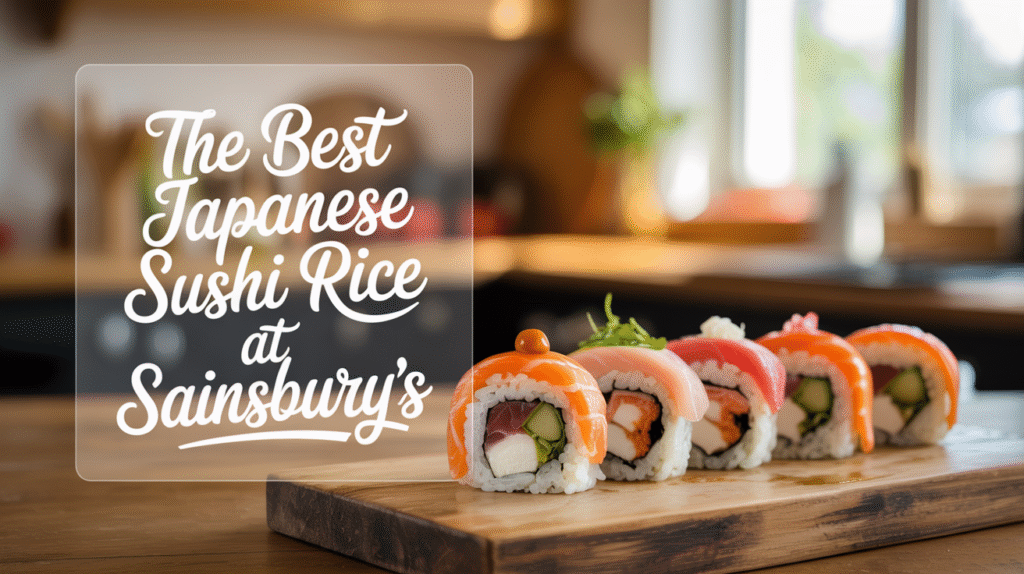The best Japanese sushi rice at Sainsbury’s is the Sainsbury’s Japanese-Style Sushi Rice (500g). It’s designed specifically for home sushi-making and delivers a sticky, slightly sweet, and short-grain texture that holds well when rolled or moulded. If you’re aiming for restaurant-quality sushi at home, this rice is the foundation you need.

Here’s everything you need to know about how this rice performs, how to cook it perfectly, and how it compares to traditional Japanese brands.
Why Sainsbury’s Sushi Rice is Ideal for Homemade Sushi
Choosing the right rice is critical to making successful sushi. Sainsbury’s Japanese-style sushi rice gets the fundamentals right—grain size, stickiness, and flavour.
Sticky Texture for Easy Rolling
Sushi rice needs to hold together without being mushy.
- Short-grain rice that sticks without being overly starchy
- Holds shape well for maki, nigiri, and hand rolls
Mild Flavour That Absorbs Vinegar Well
It’s lightly neutral so it doesn’t overpower the seasoning or fillings.
- Takes on traditional sushi vinegar mix without losing integrity
- Enhances flavours of fish, vegetables, and soy sauce
Ingredients and Cooking Instructions
You don’t need a rice cooker to get great results—just the right method and a bit of care.
Ingredients in the Bag
The rice itself is pure with no additives, which is perfect for authentic preparation.
- 100% short-grain white rice
- Non-GMO and suitable for vegetarians and vegans
How to Cook Sainsbury’s Sushi Rice
Proper cooking ensures the right stickiness and texture.
- Rinse thoroughly 3–4 times until water runs clear
- Use a 1:1.2 rice-to-water ratio for stovetop cooking
- Simmer covered for 10–12 minutes, then rest for 10 minutes
- Mix with sushi vinegar while fanning to cool
Common Uses for Sainsbury’s Sushi Rice
This rice isn’t limited to sushi rolls—you can use it in several Japanese dishes or even creative fusion recipes.
Traditional Sushi Recipes
Perfect for all types of sushi.
- Maki rolls with seaweed, fish, and vegetables
- Nigiri with slices of salmon, tuna, or egg
- Temaki (hand rolls) for easy DIY sushi nights
Beyond Sushi
This rice can be repurposed in many ways beyond sushi.
- Poke bowls with raw fish, avocado, and sesame
- Onigiri (rice balls) for lunchboxes or picnics
How It Compares to Other Sushi Rice Brands
How does Sainsbury’s sushi rice hold up against Japanese-imported brands or premium options?
Quality and Consistency
You get consistent results at a fraction of the price.
- Well-processed with minimal broken grains
- Matches performance of brands like Nishiki or Tamanishiki for most home uses
Price and Accessibility
This product is widely available across Sainsbury’s stores and online.
- Affordable without compromising quality
- No need to visit a specialty Asian store for good rice
Storage Tips for Longevity and Freshness
Storing your rice properly ensures it stays fresh between uses.
Keep It Dry and Sealed
Like all dry grains, sushi rice should be stored carefully.
- Reseal after use or transfer to an airtight container
- Store in a cool, dry cupboard away from sunlight
Shelf Life After Opening
You can keep the rice fresh for months if stored correctly.
- Use within 6–12 months for best quality
- Avoid storing near strong-smelling foods as rice can absorb odours
Is Sainsbury’s Sushi Rice Suitable for Special Diets?
Sushi rice is generally diet-friendly, and this product is no exception.
Vegan and Gluten-Free Friendly
No animal products or gluten-containing grains are involved.
- Made from a single ingredient—rice
- Safe for people with coeliac disease or on a plant-based diet
Low in Fat and Sodium
The rice itself is very clean nutritionally.
- No added salt, preservatives, or oil
- Can be balanced with healthy fillings for a complete meal
FAQs About Sainsbury’s Japanese Sushi Rice
Here are some questions and answers about Sainsbury’s Japanese Sushi Rice:
What’s the difference between sushi rice and regular rice?
Sushi rice is a short-grain variety that becomes sticky when cooked. Regular long-grain or basmati rice remains fluffy and won’t hold together for sushi.
Can I use Sainsbury’s sushi rice in a rice cooker?
Yes, it works well in a rice cooker. Just rinse it thoroughly and use the correct water-to-rice ratio (usually around 1:1.1 to 1:1.2).
Is sushi rice high in sugar?
The rice itself has a low sugar content. However, traditional sushi rice is seasoned with sugar and vinegar after cooking.
Do I need to add vinegar to this rice?
Yes, for authentic sushi taste, mix with a vinegar blend (typically rice vinegar, sugar, and salt) after cooking and resting.
Is this sushi rice suitable for children?
Absolutely. It’s soft, easy to chew, and pairs well with kid-friendly fillings like cooked egg or avocado.
